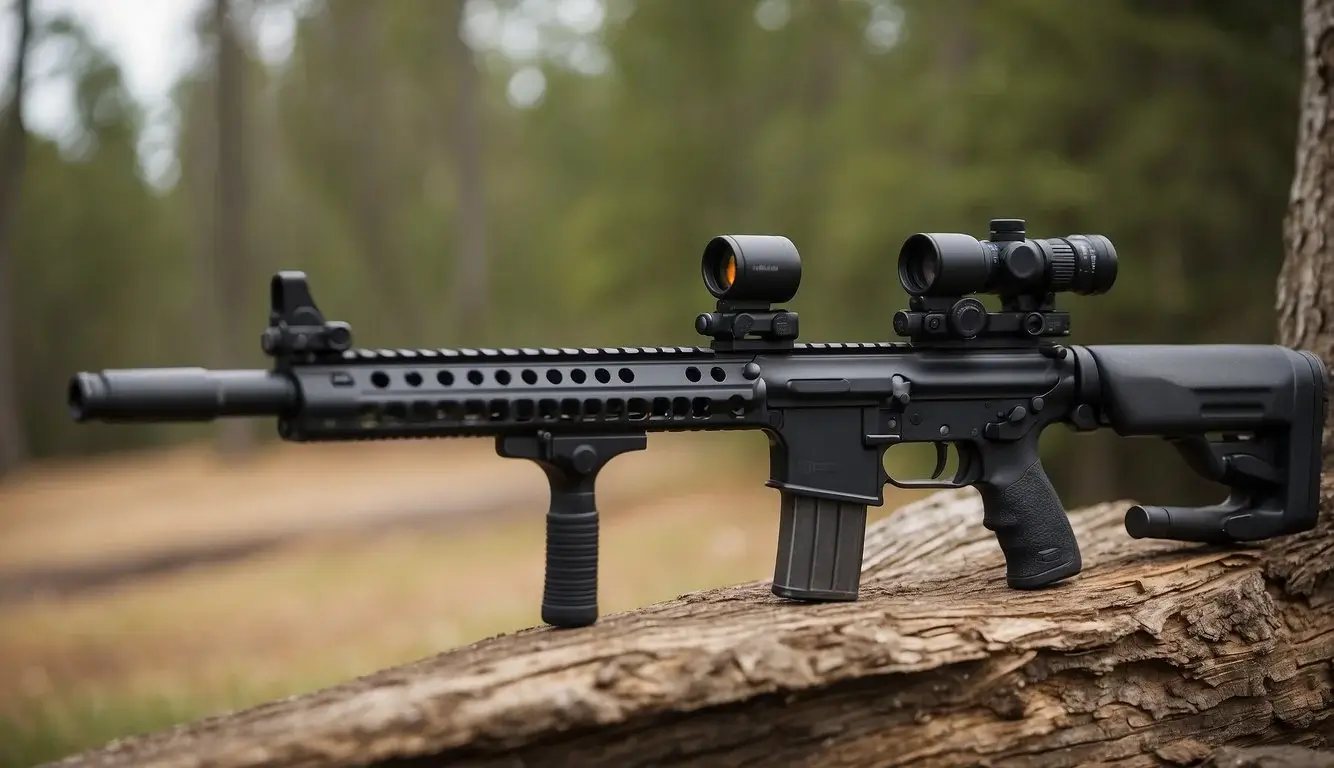I’ve invested a significant amount of time to decipher the essentials of **gun range etiquette**, creating a comprehensive guide. This guide serves as your access pass to both a secure and enjoyable firing experience. Understanding the proper conduct at a gun range is crucial to ensure the safety of all participants and to guarantee an enjoyable experience for everyone. It begins with being knowledgeable about the safe handling of firearms.
This article will walk you through the critical behaviors and practices, from handling your firearm to interacting with others, to make your time at the range both productive and enjoyable.
Key Takeaways
- Safety and courtesy are paramount in gun range etiquette.
- Protective gear, like eyewear and ear protection, is essential.
- Proper conduct includes mindful cleanup and addressing malfunctions safely.
Understanding the Basics
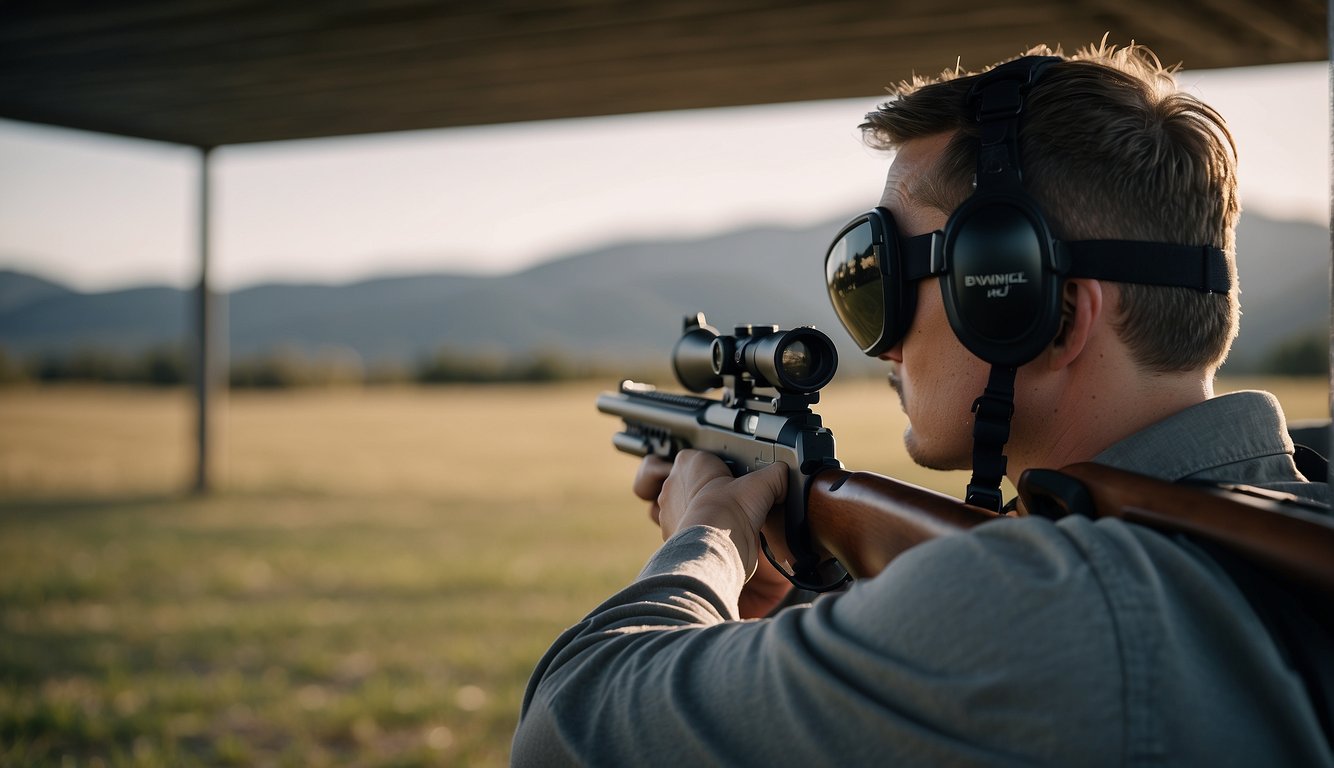
When I first started frequenting shooting ranges, I quickly learned that knowing the fundamentals of range etiquette and safety protocols was as important as honing my shooting skills. The variety of ranges and specific terminology can be overwhelming, but grasping these can make the shooting range experience much smoother and safer.
Types of Shooting Ranges
- Indoor Ranges are great for all-weather use. However, to ensure safety and reduce noise levels, the type of firearms and ammunition allowed is often restricted.
- Outdoor Ranges: These ranges typically offer more versatility for firearm types and shooting distances. You might find multiple target options and varied shooting lines.
Gun Range Terminology
- Hot Range: When the range is “hot,” it means shooting is in progress and you’re expected to follow strict safety protocols.
- Cold Range: If the range is “cold,” no firing is permitted. This is when you can safely check targets, set up, or take a break.
Remember, safety is always the primary concern regardless of the type of range or the terms used. My adherence to proper range etiquette not only ensures my safety but also that of those around me.
Before You Go
Preparing for a trip to the gun range involves more than just grabbing my firearm and heading out the door. I need to ensure that I have the right gear, understand what essentials to bring, and am in the proper mindset for a safe and enjoyable experience.
Choosing the Right Gear
The gear I select for the range is critical for safety and comfort. I always opt for comfortable yet practical clothing— avoiding anything loose that could catch on my firearm or equipment. I recommend:
- A long-sleeve shirt to protect my arms from hot brass
- Pants over shorts for added protection
- Closed-toe shoes for stable footing and shielding from falling casings
Furthermore, eye and ear protection are non-negotiable for me. High-quality safety glasses keep my eyes safe from potential debris, while earmuffs or earplugs guard my hearing from the loud reports of gunfire.
What to Bring
When packing my range bag, I ensure to include:
- Firearm(s), unloaded and stored in a case
- Ammunition appropriate for the firearm and stored safely
- Hearing and eye protection, as mentioned above
- Target(s), if the range doesn’t supply them
- Basic cleaning supplies and tools for quick maintenance
Lastly, I always check to have my gun range membership card or necessary ID/permits.
Mindset and Preparation
Ensuring I’m mentally prepared for the range is just as vital as having the right gear. I take the principles of firearm safety seriously, with the top three always on my mind:
- Always keep the gun pointed in a safe direction.
- Always keep my finger off the trigger until I’m ready to shoot.
- Always keep the gun unloaded until ready to use.
I also familiarize myself with any specific rules or procedures of the range I’m visiting. This includes understanding the commands and signals that the range officers use. This mindset and preparation ensure that I contribute to a secure environment for myself and others around me.
Arrival and Setup
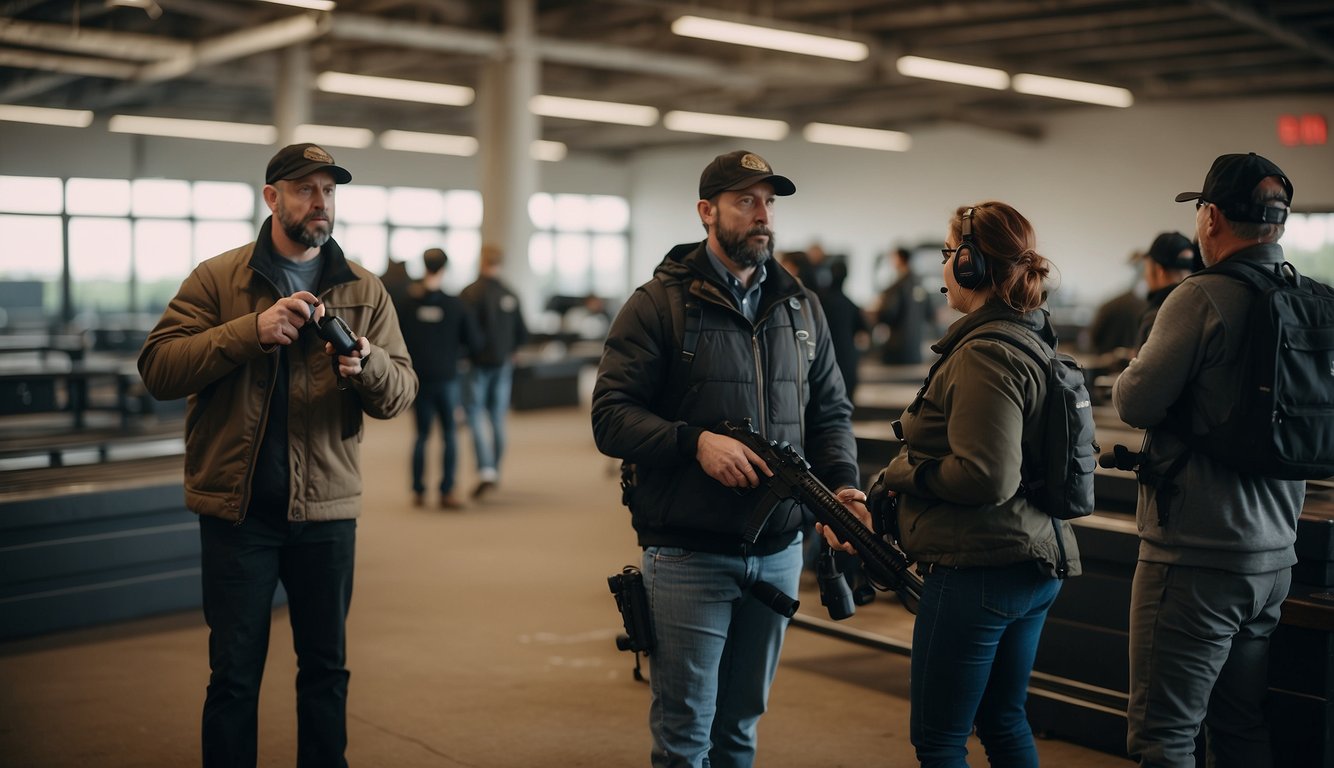
When I arrive at the shooting range, two of the most important steps I take are checking in with range staff and getting my designated lane ready for use.
Checking In
Upon entering the range, my first task is to check in with the range officer or staff. It’s crucial for ensuring safety and organization at the facility. I approach the counter with securely closed gun case and provide any required identification or membership details. If I’m a new shooter, I make a point to let the staff know so they can provide any necessary orientation or extra assistance.
Setting Up at Your Lane
After checking in, I proceed to the lane assigned to me, making sure to follow the direction of any signage or floor markings. Before I uncase my firearm, I always check to ensure that the lane is clear and it is safe to do so. At my lane, I arrange my gear neatly to avoid clutter, which could lead to accidents or hinder other shooters. I need to keep my equipment within my designated shooting area to maintain a safe environment for everyone at the range.
Safety Rules
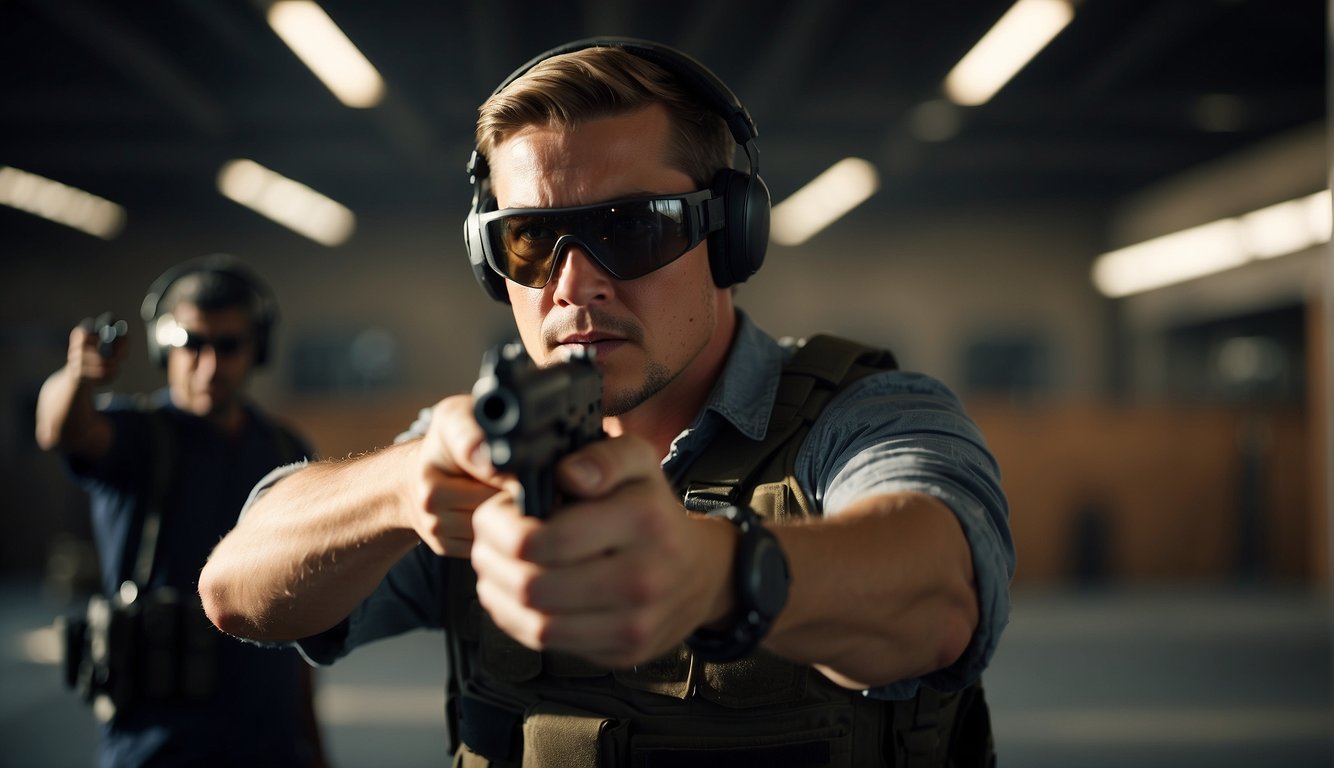
The key to enjoying a day at the gun range is knowing and strictly adhering to the safety rules. From the moment I step on the range, I make sure my actions promote safety for myself and everyone around.
General Range Safety
At the range, I always touch base with the Range Safety Officer (RSO) who supervises the facility and ensures everyone follows the range safety rules. This person has authority to restrict any unsafe behavior, and when they announce a “hot range,” it means that commence firing is permitted. Conversely, a “cold range” signals that all firing must stop, and firearms are to be placed down until the range is declared hot again.
- Hot Range: Commence firing is allowed.
- Cold Range: Cease-fire, no handling of firearms.
Firearm Handling Rules
When at the gun range, ensuring my firearm is always pointed downrange is paramount. Loaded firearms should only be present at the firing line, and before handling my firearm, I check to see if the range is hot. While the range is cold, no firearms should be touched. I keep in mind the fundamental firearm safety rules such as treating every firearm as if it were loaded and keeping my finger off the trigger until ready to shoot.
- Always:
- Keep the firearm pointed in a safe direction, preferably downrange.
- Treat every firearm as if it is loaded.
- Do Not:
- Handle firearms during a cease-fire.
- Point the firearm at anything I do not intend to shoot.
Understanding Range Commands
Listening for and understanding range commands ensures safety for everyone. “Commence firing” means I can begin shooting, while “cease fire” means to immediately stop shooting, unload my firearm, and step back from the firing line. It’s vital to remove all ammunition and show a clear chamber, ensuring there’s no lead residue left in the firearm. I always watch for these commands and respond promptly and correctly.
- Commence firing: Start shooting, following all safety rules.
- Cease fire: Stop shooting, unload, and step back from the firing line.
These rules ensure a safe and enjoyable experience for all shooters involved.
Range Etiquette
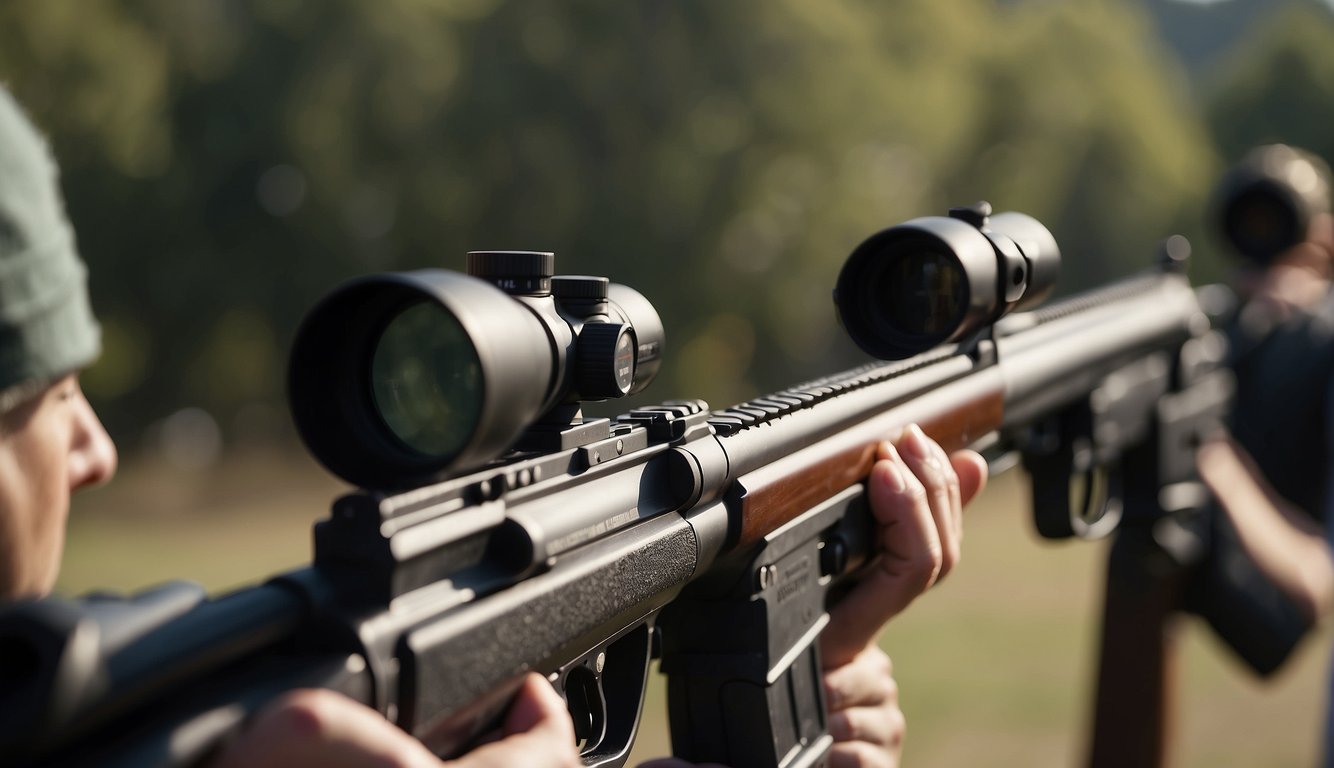
When I visit a gun range, I make sure to embrace good gun range etiquette—it’s vital for safety and courtesy. It ensures everyone has a positive experience, keeping interactions respectful and clear.
Communication and Courtesy
I always communicate clearly and politely with everyone at the range. This means I actively listen to and follow range commands, such as “ceasefire,” to ensure I’m synchronized with other shooters. If I’m unsure about something or experience a malfunction, I ask a Range Safety Officer (RSO) for help, rather than guessing and potentially making an unsafe choice.
- Speak Up: If I see unsafe behavior, I notify an RSO immediately.
- Muzzle Awareness: I keep the muzzle pointed downrange at all times.
- Hot Brass: I’m aware of where my spent casings go, ideally with a muzzle brake to direct hot brass away from others.
Sharing Lanes and Equipment
Sharing lanes and equipment is common, especially on busy days. I always negotiate with other shooters before setting up to ensure I’m not intruding on their space.
- Bench Sharing: When sharing a bench, I use just half of the surface, so I don’t crowd someone else’s area.
- Clean Up: After I’m done shooting, I must clean up—this means picking up my brass and any other trash.
Here’s a simple checklist I follow:
- Before Shooting: Communicate with fellow shooters; clearly understand all rules.
- During Shooting: Keep a watchful eye on the muzzle and parts of the gun, keeping it pointing safely downrange.
- After Shooting: Tidy my station, including sweeping brass and disposing of trash or spent targets.
Hearing and Eye Protection
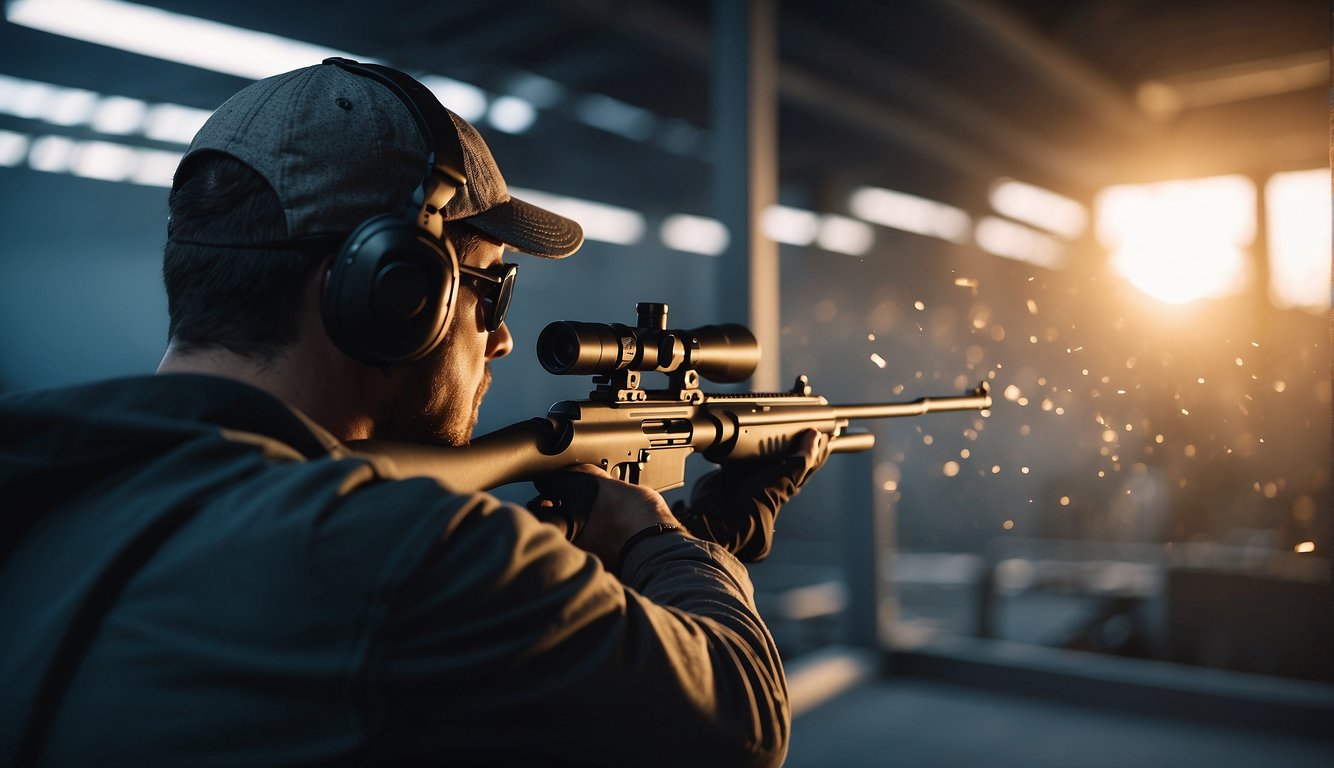
When I visit a gun range, my priority is to ensure my safety and the safety of others. A fundamental aspect of this is adhering to gun range safety rules, particularly in the use of hearing and eye protection.
Eye Protection: Securing my eyes is a must at the shooting range. Ballistic eyewear protects me from debris and ricochets. I always choose high-quality goggles or glasses rated for shooting to ensure my vision stays protected.
Hearing Protection: The sound of gunfire is exceptionally loud and can cause immediate and permanent hearing loss if proper precautions aren’t taken. I use earplugs or earmuffs every time I shoot to safeguard my ears from the hazardous noise levels. Range safety officers can often be seen reinforcing the use of hearing protection, as it’s crucial for maintaining a safe environment.
- Safety Rules: The NRA and other shooting organizations emphasize that hearing and eye protection should be used at all times during target shooting to prevent injury.
- Range Safety Officers: These individuals enforce the safety rules, and I always follow their guidance to maintain a secure shooting environment.
Here’s a quick checklist I go through before heading to the gun range:
| Item | Description | Checked |
|---|---|---|
| Eye Protection | Rated for ballistic impact | ☑️ |
| Hearing Protection | Blocks or muffles loud noises | ☑️ |
I don’t start shooting until I have both protections in place. After all, enjoying the sport of target shooting comes with the responsibility of following gun range safety rules. This way, I help cultivate a culture of respect and safety at the gun range.
Dealing with Malfunctions

When I experience a malfunction at the gun range, my primary concerns are maintaining safety and resolving the issue efficiently. Here’s how I handle these situations:
Immediate Action
The first thing I do is keep the firearm pointed downrange. I always assume the firearm is still loaded. Then, I attempt basic immediate action to clear the malfunction, such as “tap-rack-bang” for a semi-automatic: tap the magazine to ensure it’s appropriately seated, rack the slide to clear the chamber, and attempt to bang or fire again if the range is clear.
When to Seek Help
If my immediate action doesn’t resolve the issue, I keep the gun pointed downrange and avoid the temptation to troubleshoot further, as this may lead to unsafe behavior. Instead, I signal for a range officer, whose job is to maintain range safety and who is trained to deal with such situations. I wait for their instructions or assistance to ensure the malfunction is handled safely.
Clean-Up and Leaving
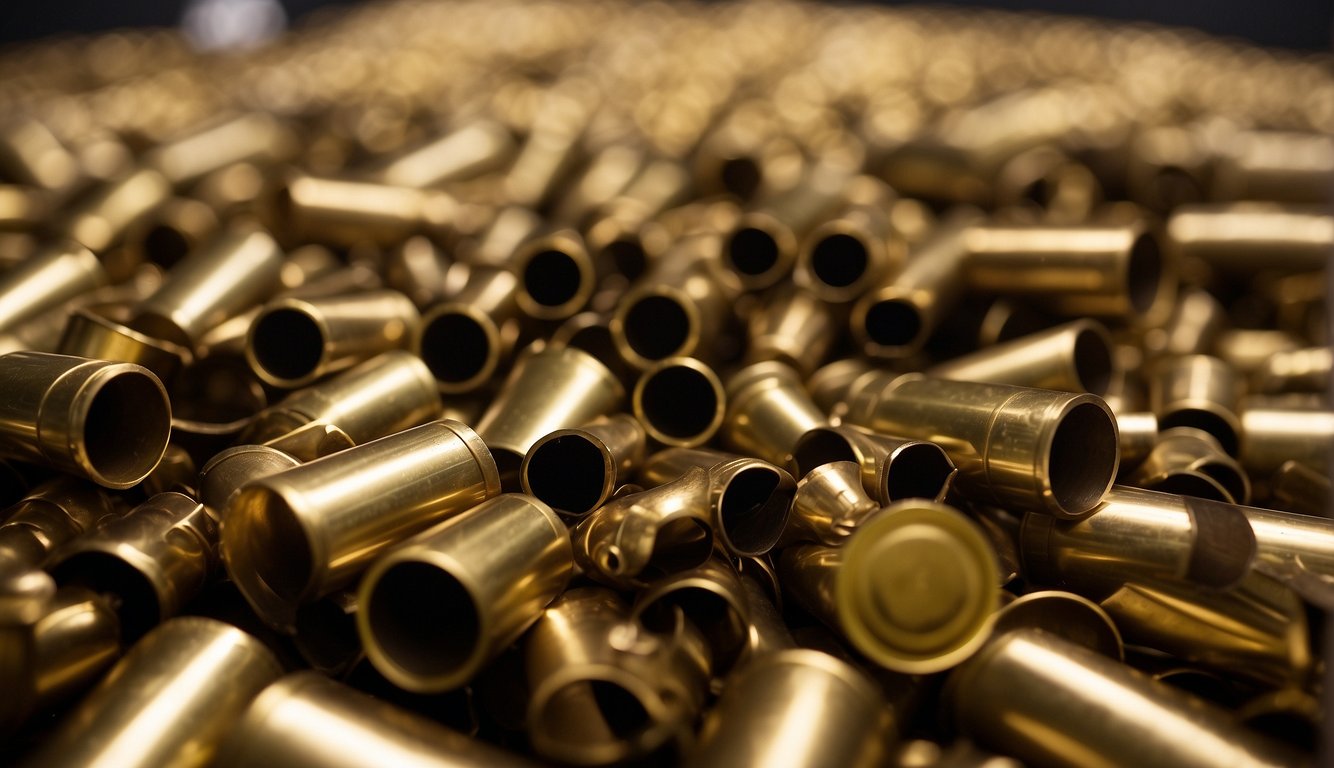
After a fulfilling session at the range, it’s important for me to ensure that I leave my space in the same—or better—condition than I found it. Not only is this considerate, but it helps promote a culture of respect and safety among fellow shooters.
Cleaning Your Space
When I finish firing, I always make it a point to clean my space properly. This means I need to sweep up any brass that has fallen to the ground and dispose of it in the designated receptacles. I pay close attention to collect all of the casings, because if left behind, they could pose a tripping hazard or cause issues for the next shooter. Cleaning up any lead residue is equally important for maintaining a safe environment, so I wipe down all surfaces.
- Lead residue removal: Wipe surfaces and clean the floor
- Brass collection: Pick up all spent casings
- Personal items: Gather all my gear and personal belongings
Moreover, it’s vital to remember that having no food or alcohol at the range is a strict policy for safety and hygiene reasons. After all, nobody wants to handle firearms with greasy hands or impaired judgment.
Checking Out with Range Staff
Before I exit the range, I check out with the range staff. This is the perfect time to report any issues or abnormalities I might have spotted, like problems with the backstop or other equipment. It’s a good practice and it maintains a channel of open communication with the staff, who are responsible for everyone’s safety.
- Report to staff: Communicate any issues or concerns
- Return equipment: If I rented or used range gear, I return it in good condition
Making sure I’ve left nothing behind and that my area is spick-and-span is just as much a part of gun range etiquette as following the rules while shooting. It’s about showing respect to the range staff and the shooters who will come after me.
Special Considerations

When visiting a gun range, I need to follow important protocols to ensure my safety and the enjoyment of others. Some rules might not be immediately obvious, so I must understand these special considerations.
For New Shooters
If you’re a new shooter, familiarize yourself with the basic range commands and safety guidelines. It’s essential to know the meaning of terms like “ceasefire” and understand range layout. Always ask for a safety briefing before you commence shooting. Remember, asking questions is a good thing – it shows you’re serious about safety.
Alcohol and Drug Policies
Gun ranges strictly enforce no-tolerance policies for alcohol and drugs. Even prescription drugs that may impair your motor skills or judgment are often prohibited. Double-check with range staff for approval and safety measures if you’re on medication.
Food and Drink Restrictions
Many ranges restrict food and drink consumption to maintain cleanliness and safety. It’s a standard rule not to have food or alcohol at the range. This protects both shooters and the equipment from potential contamination and dangers like accidental ingestion of lead particles. Always dispose of trash properly and keep your shooting space clean.
Addressing Misconceptions
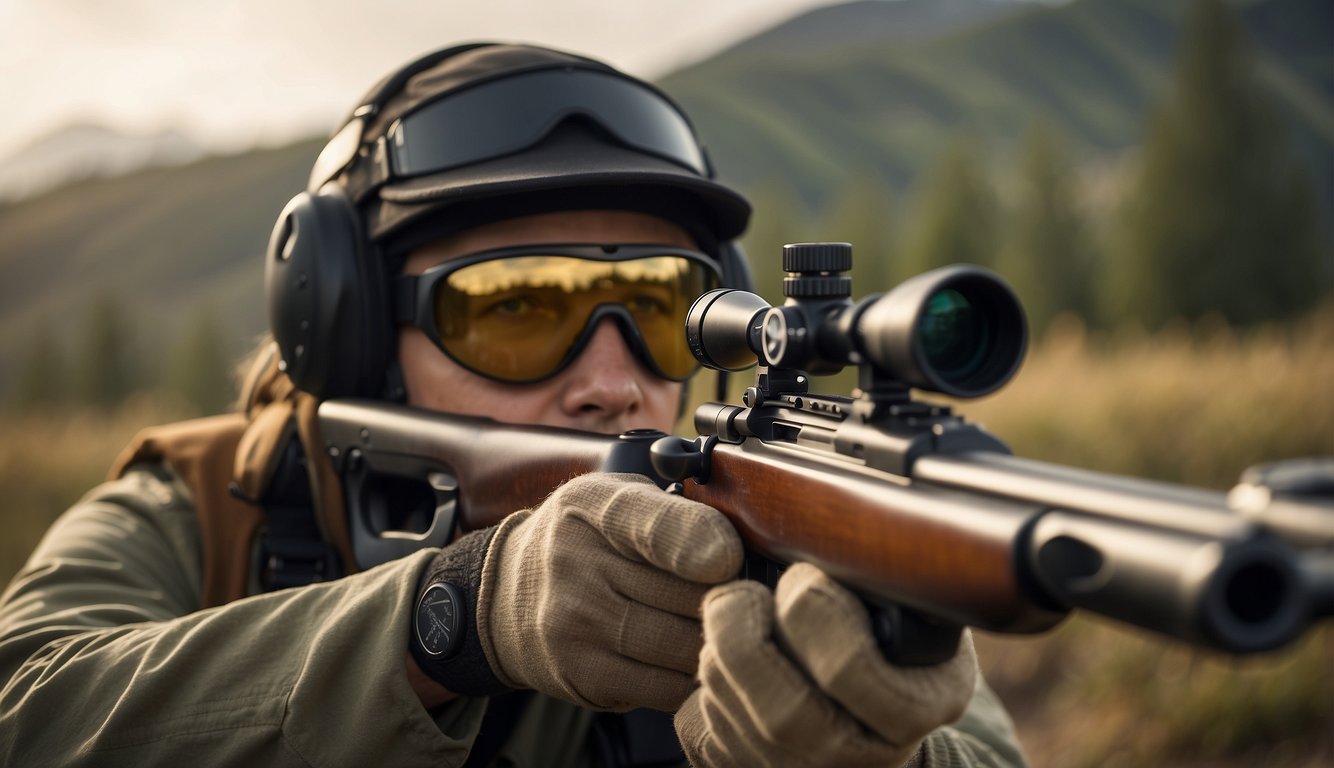
Before I dive into specifics, it’s important to tackle some misconceptions about shooting ranges that might be causing unnecessary apprehension for newcomers.
Common Myths about Shooting Ranges
Myth 1: “Shooting ranges are intimidating and unsafe.” That’s far from the truth. Safety is the top priority at ranges. The NRA lays out clear firearm safety protocols which most ranges adopt and enforce rigorously to ensure a secure environment. These include always keeping the gun pointed in a safe direction and keeping your finger off the trigger until you’re ready to shoot.
Myth 2: “You need to be experienced before going to a range.” Actually, shooting ranges are the perfect place for beginners. They offer a controlled setting where you can learn and practice. Range officers and instructors are often available to guide you through the basics of gun range safety and marksmanship.
Benefits of Regular Practice
Affected Skillset: Precision shooting and situational awareness By investing range time consistently, I see improvements in my precision and become more situationally aware, both crucial aspects of responsible firearm use.
Confidence & Familiarity: Regular visits to the range help in building familiarity with my firearm, making its operation second nature to me. This is in line with effective firearm safety since a well-understood weapon is a safer one.
Practicing shooting on a regular basis isn’t just about marksmanship, it’s about reinforcing safe handling habits—essentials that the NRA and shooting educators emphasize for both recreational and defensive firearm users.
FAQ – Gun Range Etiquette
Is it necessary to wear protective gear at the range?
Yes, always wear appropriate eye and ear protection. Most ranges require this as a mandatory safety measure to protect against flying casings, loud noise, and potential debris.
Should I bring my own firearms and ammunition, or can I rent them at the range?
Many ranges offer rental options for firearms and sell ammunition. If you’re bringing your own, check the range’s rules beforehand to ensure your firearms and ammo types are permitted. Always transport your firearms safely and legally.
How should I behave when not actively shooting on the firing line?
When you’re not shooting, step back from the firing line and keep your firearms unloaded and safely holstered or cased. Be mindful not to distract others or interfere with their concentration and safety.
If you enjoyed reading about Gun Range Etiquette, check out our other articles:
- Bowling Etiquette 2024: Tips for Polite Play on the Lanes
- Surf Etiquette 2024: Key Rules for Sharing the Waves
- Tennis Etiquette 2024: Key Rules and Polite Play for Beginners
- Laundromat Etiquette 2024: Tips for a Harmonious Wash Day
Feel free to also check out our other Articles from the category “Etiquette & Manners“ and don’t forget to follow us on Pinterest

